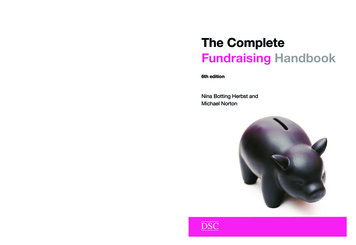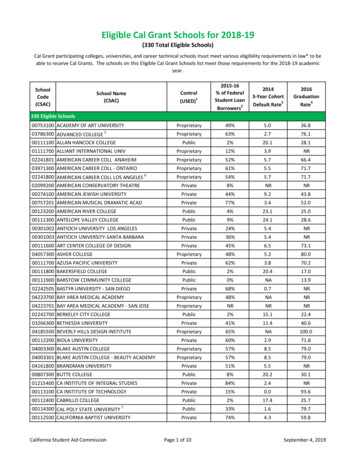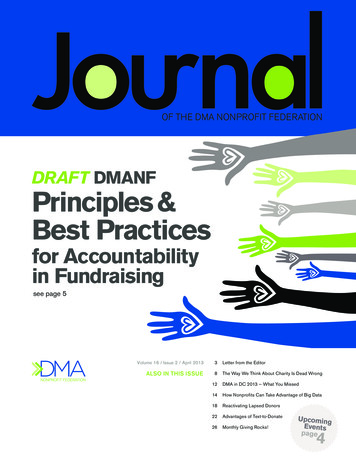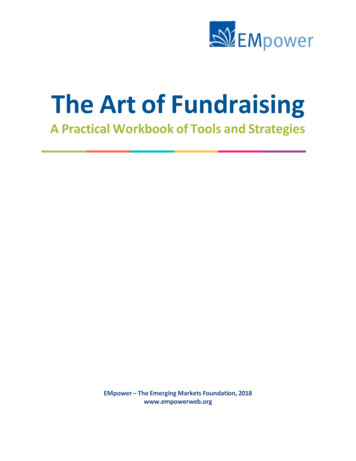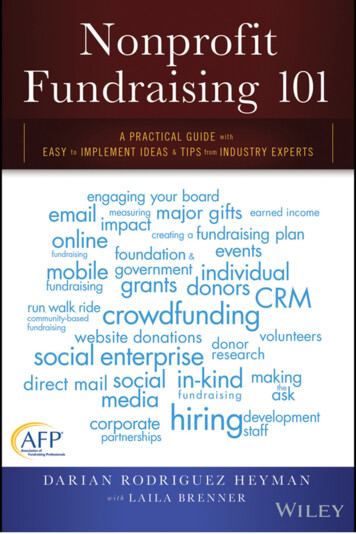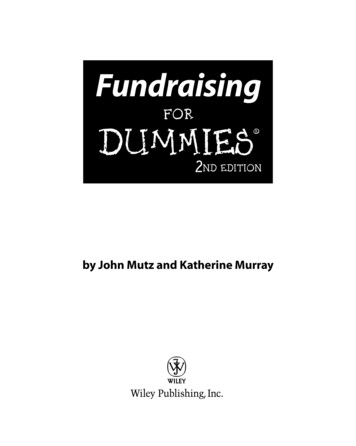
Transcription
FUNDRAISING IN SCHOOLS: CHALLENGES, ISSUES,GUIDELINES, AND POLICIESPresented By:Michael S. Tan, Ph.D.Associate Professor of EducationWilliam Woods UniversityFulton, Missourimtan@williamwoods.edu63rd Annual Conference of the Education Law AssociationThe Sheraton San Diego, San DiegoNovember 8-12, 2017
1FUNDRAISING IN SCHOOLS: CHALLENGES, ISSUES, GUIDELINES, ANDPOLICIESMichael S. Tan, Ph.D.Associate Professor of EducationWilliam Woods UniversityThis paper will examine the use of fundraisers and fundraising activities and thechallenges and issues surrounding the conduct of these activities. Various legalissues such as federal, state, and constitutional violations, including tort liabilityfrom various constituents or parties involved, i.e. the students, the parents, theschool, the school district, the PTO, booster clubs, and those who oversee thesefundraising efforts or activities are discussed. Finally, practical guidelines orprinciples and policies for minimizing liability and violations when using schoolfundraisers are suggested.INTRODUCTIONFundraising and fundraisers have been around in public schools for a longtime and may have actually increased in recent years. A large majority ofschools use fundraising activities to raise money from external sources to fundand support co-curricular activities and other school functions. This may be dueto shrinking school budgets or the school’s desire to supplement costly cocurricular activities or endeavors or to meet a school club or association’smission, needs, or goals. It is imperative for schools, particularly schooladministrators to be cognizant of the many challenges and issues surroundingschool fundraising activities, understand the guidelines, and have policies inplace to deal with the legalities involved with fundraisers in order to minimizeschool liabilities and potential lawsuits.
2PURPOSE OF FUNDRAISING ACTIVITIESThe increase in fundraising activities in schools to seek additional moniesis becoming more and more especially when schools face difficult financial timesof budgetary cuts or shortfalls.Fundraisers or fundraising activities are generally carried out to raisefunds, considered as alternative sources of revenue, for the school or district, forthe purposes of: Aiding an academic club or organization in the school Aiding an athletic, sports, or extracurricular program Aiding a particular student or group of students Aiding the school or district as a whole Supplementing the traditional funding from federal, state or localgovernments due to budget shortfallsOther purposes of fundraising activities include “raising awareness for thecommunity to come together, thus building a strong community; highlightingimportant educational skills, and instilling a sense of social awareness and moralvalues in the minds of our youth.” 1 They “also inculcate school spirit whichenhances the experience for student participants.”21Kathy Diiorio, Former elementary school teacher and principal. Personalinterview in Cash for Your Classroom: Expert Tips and Resources for RaisingFunds and Building Relationships. Available s/school-fundraising/2 Schultze, R.R. & Perry, G. H. (2014, November 21). F-5 – “Legal Issues toConsider with Booster Clubs and PTA’s”. Available rence/2014/Handouts/F5.pdf
3DEFINITION OF “FUNDRAISER” OR “FUNDRAISING ACTIVITY(IES)“Fundraiser” or “Fundraising Activity(ies)” refer to a school or districtsponsored activity or event that uses students to generate funds.3 Fundraisersor fundraising activities can come in the form of group or individual; the formerrefers to funds raised for the mutual benefit of a particular organization or team,while the latter refers to funds that are being raised to help subsidize or pay foran individual student’s costs. Fundraisers or fundraising activities generallyinvolve or use students to generate funds or monies for the organization, team,or individual. Alternative forms/streams of fundraising activities which alsogenerate revenue for schools that may not use students include unsoliciteddonations such as private donations from individuals or organizations,unobtrusive programs such as Box Tops for Education, Labels for Education,Penny Wars, etc. and advertising in the bus, class newsletter or schoolnewspaper, or in the local newspaper.TYPES OF FUNDRAISING ACTIVITIESA popular type of fundraiser or the historical method of fundraisingcommonly used by schools to raise monies, is through the sale of food andbeverage items on campus such as bake sales, candy sales, and sales of sugarydrinks.4 Food-related fundraisers are common and have been around for manyyears. According to study by the Centers of Disease Control and Prevention in2006, the sale of foods and beverages occurred at 76% of elementary schools,3Nebo School District Board of Education. (2016, December 14). Policies andProcedures. Section: K-School/Community Relations. Policy Title: SchoolFundraising Activities. Available at: www.nebo.edu/pubpolicy/K/KAC.pdf/4Caparosa, S.L., Shordon, M., Santos, A. T., Pomichowski, M.E., Dzewaltowsk,D.A., & Coleman, K.J. (2013). Fundraising, Celebrations, and ClassroomRewards are Substantial Sources of Unhealthy Foods and Beverages on PublicSchool Campuses. Public Health Nutrition, 17(6), 1205-1213
478% of middle schools, and 84% of high schools.5 Other food-related fundraisingstrategies comprise spaghetti dinners, pizza dinners, sponsored fundraiser nightsat local restaurants, sale of food through student stores, snack bars, vendingmachines, concession stands, and/or at special school events, and as part ofbooster club activities, etc.A second type of fundraising may be through the sale of non-food itemssuch as the sale of flowers, or seeds, local restaurant coupon books, magazinesubscriptions, wrapping paper, raffle tickets, auctions, game nights, movie nights,recycling programs, advertising, student-run stores, etc.A third type of fundraising may include the use of physical activities suchas fun runs, walks, jog, or bike-a-thons, sponsored by the Parent TeacherOrganization/Association (PTO/PTA) or by the school or district.Another type of fundraising may come directly through advertising orthrough an online medium like social media soliciting donations of privateindividuals or organizations in the community to the school or district to fund aspecific activity, program, or project. They usually do not involve the participationof students or parents. Many schools sell advertising space on school buses, inhallways, on athletic uniforms, and just about anywhere else. Commercial andpersonal ads can be placed in athletic event programs and the programs arethen sold at athletic and sporting events.A final form of fundraising may be conducted by an independent parentgroup, such as the PTA/PTO or booster clubs to raise funds for a school topurchase new computers, playground equipment, pay for academicprogramming, classroom supplies, materials for the school, band trips, state andnational athletic competitions, athletic or sports equipment, extracurricularprograms, etc.O’Toole, T.P., Anderson, S., Miller, C., Guthrie, J. (2007). Nutrition servicesand foods and beverages available at school: Results from the School HealthPolicies and Programs Study. Journal of School Health, 77(8), 500-521.5
5The aforementioned is not an exhaustive list of fundraisers or fundraisingactivities, however, it is one that is fairly representative and commonly used byschools and districts. These fundraisers or fundraising activities are generallyconducted during the school day or outside of the school day by students,parents, volunteers, and/or other community groups or organizations,LAWS ASSOCIATED WITH FUNDRAISINGSchools and school districts need to be mindful of federal, state, and locallaws that govern the use of fundraisers and fundraising activities in areas such astort liability (negligence), food, nutrition, and wellness compliance, gender equitybased on disparate benefits under Title IX, freedom of expression and freedom ofreligion rights under the First Amendment, licensing, taxes, copyright issues, etc.The laws that surround fundraisers and fundraising activities are as follows:FEDERAL LAWSChild Nutrition and WIC Reauthorization Act of 2004. P.L. 108-265, Section204, 2004. This law which took effect at the start of the 2006-07 school year,requires that school districts develop wellness policies. Wellness policies havealso included nutrition guidelines related to fundraisers, fundraising practices andactivities.The Healthy, Hunger-Free Kids Act (HHFKA) of 2010. This piece of legislationprovides strong nutrition standards for school meals and other foods sold tochildren on school campuses, and also sets new rules on school fundraisers thatsell food such as bake sales, snacks sold in school vending machines, school
6stores, and onsite cafes. A summary of this piece of legislation and associatedregulations concerning fundraisers6 is provided below: Requires the US Department of Agriculture (USDA) to establish nutritionguidelines for all foods sold on the school campus7 at any time during theschool day, including food sold outside the school meal programs. Allows USDA to consider “special exemptions for school-sponsoredfundraisers (other than fundraising through vending machines, schoolstores, snack bars, a la carte sales, and any other exclusions determinedby the Secretary), if the fundraisers are approved by the school and areinfrequent within the school.” Does not require foods sold as part of fundraising activities that take placeoutside of school to comply with the nutrition standards if the foods will notbe consumed on school property. (So, students may distribute order formsand foods not intended for consumption at school, such as frozen cookiedough, on campus.) 8 However, state agencies or school districts, throughtheir wellness policies, can prohibit or limit fundraisers during which thesetypes of foods are sold. Authorizes the state agency overseeing the school meals programs toallow exemptions from the nutrition standards for foods and beveragesthat are sold during “infrequent school-sponsored fundraisers.”96Healthy, Hunger-Free Kids Act and School Fundraisers. (2015, September).Changelabsolutions.org. Retrieved /HHFKA-school-fundraisers7 42 U.S.C. § 1779(b)(1)(B). In interpreting the Act, the USDA defines schoolcampus as all areas of the property under the jurisdiction of the school that areaccessible to students during the school day. School day means the period fromthe midnight before, to 30 minutes after the end of the official school day.8 USDA, Smart Snacks in School Fundraisers Fact Sheet, available at:www.fns.usda.gov/sites/default/files/allfoods fundraisers.pdf9 National School Lunch Program and School Breakfast Program: NutritionStandards for All Foods Sold in School as Required by the Healthy, Hunger-FreeKids Act of 2010, 78 Fed. Reg. 39068, 39093 (June 28, 2013) (amending 7C.F.R. Parts 210, 220), proposed § 210.11(b)(4), emphasis added.
7 Requires the state agency to specify the number of exempt fundraisers orfundraising days (i.e. the frequency of fundraisers) that schools may have.The agency can set this number at zero. If the agency does not specifythe allowable frequency, schools within the state may not hold any exemptfundraisers. Prohibits the sale of exempted fundraiser foods or beverages in the foodservice area during the meal service.10If the State allows schools to hold exempt fundraisers: Fundraisers must be approved by the school; Fundraisers cannot be held in the food service area during the mealservice; and Foods and beverages sold from vending machines, school stores, snackbars, and a la carte sales cannot be exempt from the minimal nutritionstandards, even if a school uses these venues to raise funds for theschool.USDA Smart Snacks School Nutrition Standards (July 2014). With schoolnutrition being the focus of national policy efforts and following passage of theHealthy, Hunger-Free Kids Act of 2010, the government mandated new rules forcompetitive foods and beverages known as “Smart Snacks.” “Competitive foodsand beverages” refer to food items that are not part of the traditional school mealand are sold on school campuses before the start of the school day to 30minutes after the end of classes. With this in mind, the USDA developed theSmart Snacks School Nutrition Standards which define portion sizes and types offoods and beverages that may be sold outside of school meals on schoolcampuses during the school day in the three venues of vending machines,school stores of snack bars, and a la carte lines in the cafeteria. Among the newregulations is a requirement that snack items to have 200 calories or less.1042 U.S.C. § 1779(b)(1)(C)(ii)(IV)
8Sodium must be 230 milligrams or less and will drop to 200 milligrams in 2016.11The Smart Snacks Standards also allow states to create an exemption from theregulations allowing a certain number of at-school fundraisers involvingcompetitive foods and beverages that do not meet Smart Snacks nutritionalguidelines if they so choose (Child Nutrition Act 2010). Many states have a zeroexemption policy meaning any products sold on a school campus as a fundraisermust comply with the Smart Snacks standards. However, the standards allow foroccasional special exemptions for fundraisers, whereby non-compliant items maybe sold on campus during school hours.12 The number of allowable exemptionsis left to the purview of the state agency overseeing child nutrition and variessubstantially from state to state. As of 2014, the state of Missouri has a policyallowing five exempt, one day fundraisers annually, per school building.13 Priorto the Smart Snacks standards, state laws and district policies were lacking in thepractice of placing limited restrictions on fundraisers.Title IX of the Education Amendments Act of 1972. This federal law prohibitsdiscrimination on the basis of gender for institutions receiving federal funding.The extent to which this piece of legislation is used in regard to fundraisers andfundraising activities is looking at the disparate benefits that may result in genderinequity and discrimination. Title IX requires that schools must ensure thatequivalent benefits and services be provided to members of both sexes:Where booster clubs provide benefits and services that assist only teams of onesex, the school shall ensure that teams of the other sex receive equivalentbenefits and services. If booster clubs provide benefits and services to athletes11No More Bake Sales? New Federal Nutrition Rules Could Challenge SchoolFundraisers. (2014, July 21). Education. Available ticle13869755.html12 U.S. Department of Agriculture. Food and Nutrition Service. National SchoolLunch Program and School Breakfast Program: Nutrition standards for all foodssold in school as required by the Healthy, Hunger-Free Kids Act of 2010. Interimfinal rule. Federal Register, 2013; 78(125):39067-39120.13 Smart Snacks: State Agency Fundraising Exemption. Available at:https://schoolnutrition.org/uploadedFiles/News and pdf
9of one sex that are greater than what the institution is capable of providing toathletes of the other sex, then the school shall take action to ensure that benefitsand services are equivalent for both sexes.14Constitutional Law.First Amendment to the U.S. Constitution. Fundraisers and fundraisingactivities/campaigns must comport with the First Amendment’s Establishmentand Free Speech clauses. With the Free Speech and Establishment Clauses,school systems must be cognizant of constitutional violations when raising fundsthrough “buy a brick” fundraisers especially when religion is involved with thecontent of “inscribed” religious messages, or even with the use of “explicit”religious messages. School administrators must weigh the risks involved whenthe public or community are invited to place personal messages on public schoolproperty or through advertising in fundraising activities so there are no violationsof the Free Speech Clause according to the First Amendment.Tort Law. In tort law, negligence is an area that school officials must be mindfulof the hazards, dangers, and take the necessary precautionary measuresespecially with fundraising activities that involve young students going from doorto-door selling things in the community to avoid liability claims. Liabilities can takedifferent forms such as inadequate supervision, assault, sustaining a physicalinjury, rape, murder, kidnapping, etc. In order to avoid negligence claims, schoolofficials must not violate the four elements required for negligence to be evident,i.e. the duty of care, breach of duty, proximate cause, and injury. Educators areheld to the standard of a reasonable parent or prudent person in negligenceclaims. Board policies should address negligence and liability issues that mightarise from conducting fundraising activities.14Office of Civil Rights, Title IX Athletics Investigator’s Manual.
10STATE AND LOCAL LAWSState and Local Ordinances Pertaining to Taxes, Licensing, Copyright,Nutrition & WellnessEducators must be cognizant and in compliance with existing localordinances and state laws that affect fundraisers and fundraising activities inareas such as licensing requirements and/or copyright issues with the use ofmovies or videos as fundraisers, state raffle laws governing licensing, the sale ofraffle tickets, the values of prizes, or the format of tickets, etc., the imposition oflocal or state sales taxes, exemptions permitted for fundraisers, restrictions as itpertains to access to the community for students involved with sales of fooditems or products, and local ordinances and state nutrition requirements andwellness guidelines related to food preparation and sales. For example, the stateof Missouri developed The Missouri Eat Smart Guidelines Grades Pre-K-12(2006) to guide the development of local wellness policies and provide suggestednutrition standards for school meals, a la carte items, vending/school stores,other foods available at school, and before- and after-school programs at threedifferent levels: “Intermediate,”, “Advanced,” and “Exemplary’. 15 The minimumlevel complies with the minimum requirements for all school meals established byfederal Child Nutrition Program regulations and state policy. The standards foreach subsequent level are more healthful than those for the previous level.LEGAL CHALLENGES AND ISSUESThere are many legal challenges and issues that schools and districts mayface with regard to fundraisers and fundraising activities, whether it be throughthe sale of food items, non-food items, or any another activity forms. Thesechallenges are based on the legalities surrounding fundraisers and questions thatarise may include: 1) whether the fundraising activities are legal or illegal, 2) whatThe Missouri Eat Smart Guidelines Grades Pre-K – 12. 2nd edition. Availableat: r t%20Guidelines.pdf15
11are the legal liabilities of using fundraisers and fundraising activities and riskmanagement strategies that the school or district must be aware of? Is the schoolor district liable for any mishaps, injuries, or negligence resulting in student orparental involvement or participation in fundraising activities? 3) what is theobligation of the school or district to provide proper instructions to reduce the riskof injury, warnings regarding known or foreseeable hazards, and providingadequate supervision? 4) what are the constitutional violations involving the FirstAmendment rights such as free speech or the establishment of religion if andwhen personal or religious messages are placed on tangible items to be sold asfundraisers? 5) are there any federal, state, or local food/nutrition guidelines,health and wellness laws that schools must comply with when fundraisers usingfood items are involved? 6) are there problems associated with nutrition practicescontributing to childhood or students’ obesity16 when food-related fundraisers areinvolved? 7) can booster clubs or Parent Teacher Organizations/Associations(PTO/PTA) be held liable for violations of Title IX on disparate impact grounds?8) what are the liabilities of using fundraisers and fundraising activities involvingthe sale of non-food items, the use of physical activities, or the solicitation ofprivate donations or funds? 9) what are the issues involved when fundraisingactivities are conducted over the Internet? and 10) does the school or districthave guidelines or policies in place involving fundraisers and fundraisingactivities when they are conducted in school or off-school grounds?With all these challenges and legal issues that schools will encounter withfundraising activities, it is imperative that school administrators take thenecessary precautions to not only minimize district liability and be cognizant offederal, state, and local laws, so as to be compliant and avoid violations of thelaw.16Kubik, M.Y., Lytle, L.A., & Story, M. (2005). Schoolwide food practices areassociated with body mass index in middle school students. Arch PediatricAdolescent Medicine, 159(12), 1111-1114.
12GUIDELINES ON FUNDRAISING ACTIVITIESIn view of all the challenges and legal issues, it would be wise for schoolsand districts to develop guidelines and policies associated with fundraisingactivities. This would protect all parties involved in the fundraising efforts andactivities and absolve the school and district of any liabilities arising from theimplementation of these activities. A list of practical guidelines and principles forminimizing liability involving fundraisers and fundraising activities in schools anddistricts are discussed and presented below:1). Determine the Purpose/s of FundraisingBefore commencing fundraising activities, it is important that the purpose/sare understood by all the parties as to why it is necessary and that the proceedswill be used for the purpose/s it was intended to begin with. Any proceeds fromthe fundraising activities should be spent for the benefit of the individual student,the entire student club or group, or the school depending on what the purposeswere established in the first place. Funds raised should not be used to replacepublic education funding or support items funded through school or districtbudgets.2). Determine the Appropriateness of Fundraisers UsedIt is important to determine the appropriateness of using certainfundraisers, particularly the ones involving the sale of food items such as candybars, cookie dough, or beverages such as soda to raise money. These fooditems are deemed to be unhealthy and consumption of “empty calories” from thesolid fats and added sugars in these products may cause obesity in children intheir later years.17 The number of overweight, obese, and inactive students havebeen on the rise in recent years. Through the sale of unhealthy foods, schools17U.S. Department of Agriculture and U.S. Department of Health and HumanServices. (2010). Dietary Guidelines for Americans 2010. 7th ed. Washington,D.C.: U.S. Government Printing Office.
13may be sending mixed messages to the students as parents and schools are inthe business of supporting activities aimed at keeping students healthy and wellso as to help them achieve academic success. Therefore, it would be ideal tolimit food fundraisers to healthier food/beverage items. Advocating forfundraisers to instead use non-food items to raise money through physical andhealth activities such as a jog- or bike-a-thon would be even better. Local schoolwellness policies should include language that addresses healthier fundraising.183). Ensure Gender Equity and Non-Discrimination in Funds DistributionSchool groups and non-school groups that conduct fundraisers andfundraising using booster clubs, corporate sponsorships, private donations,alumni, etc., might want to ensure that discrimination is not evident in thedisparate economic benefits received by either gender groups based on thedifferent level of fundraising success or lack thereof. Booster clubs for boys’teams may be and are generally more successful at fundraising than girls’ teams.To be compliant with Title IX legislation, a school must ensure gender equity inthat equivalent benefits and services be provided to members of both sexes eventhough the booster club/s assist only team/s of one particular sex. Athleticdirectors are, therefore, required to track the flow of funds being distributed bybooster clubs to ensure non-discrimination and gender equity. When outsideresources result in inequity between boys’ and girls’ programs, the school mustuse its own funding to correct the inequities, if necessary. An equitable methodof fund distribution would be for all the funds raised by all the booster clubs to bepooled together into one single large fund and then redistributed to all the athleticclubs or programs equally to avoid disparate impact claims or violations of TitleIX. The principal or his or her designee should monitor fundraising activities andbe present at all booster club meetings to ensure equitable treatment of groupsor teams, and the provision of equal benefits. In Capital Gymnastics Booster18California Project Lean. Fact Sheet: Fundraising in Schools. Retrieved fromwww.CaliforiaProjectLean.org
14Club, Inc. v. Commission of Internal Revenue,19 a case involving a Virginiabooster club’s practice of crediting individual families with points towards theirathlete’s annual fees and assessments based on the amount of money raisedthrough fundraising activities, a U.S. Tax Court found that the practice benefittedonly certain athletes and families in violation of rules governing tax-exemptorganizations, and that fundraising credits are not charitable. The InternalRevenue Service revoked the Club’s nonprofit tax exemption in 2008. A federaljudge upheld the decision in August 2013.20 Fundraising should benefit all thestudents on the team or in the club and not only a select few. Students whosefamilies do not participate in fundraising activities should not be penalized.4). Being Proactive About Legal Challenges and IssuesSchool officials should be proactive and take into consideration the legalchallenges and issues associated with fundraising activities, especially those thatinvolve liability and risk of injury to all the participants involved. Car washes, foodsales (improper handling concerns), carnivals with bounce houses and dunkingbooths create situations where injuries may result without proper supervision orsufficient safety measures in place. Schools must either provide such safetymeasures or clearly disclaim to all participants any school involvement in theactivity. School administrators should check the school’s insurance policies toensure that coverage exists for all parties involved in the event of any injury.21This is all the more crucial especially when it comes to door-to-door fundraisingsales of food or non-sale food items by students in the community. Many districtsnow discourage door-to-door fundraising after a sixth-grade student selling19Capital Gymnastics Booster Club, Inc. v. Commission of Internal RevenueAvailable o.Gustafson.TCM.WPD.pdf20 Tax Court Rules on Common Fundraising Practice. PTO Today. Available tice21 Schultze, R.R. & Perry, G. H. (2014, November 21). F-5 – “Legal Issues toConsider with Booster Clubs and PTA’s”. Available rence/2014/Handouts/F5.pdf
15wrapping paper and candy was murdered and in another case, a young femalestudent was raped. The court found a fundraising company liable in the rapecase involving a 10-year old female student who participated in a fundraiser in asuit brought by her parents in R.W. and C.W. v. Punxsutawney Area SchoolDistrict et al.22, Precautionary measures should be in place to minimize school ordistrict liability and avoid potential lawsuits by students, parents, or communitymembers. Schools are now suggesting that if children go door-to-doorfundraising, older siblings or adults, or parents accompany them when they selland deliver the products. Some districts suggest only selling to relatives, friends,close neighbors, and parents’ co-workers for safety reasons.Issues related to constitutional violations of the Free Speech Clause andthe Establishment Clause under the First Amendment should be considered inplanning for a “brick” fundraiser when it comes to the content of inscribedmessages and the extent to which the messages merit restriction. So, withrespect to religious messages, should the entire, or some be excluded, or noneat all? Who should approve the messages and what should the process involve?And with brick inscriptions, schools can get stuck between a rock (EstablishmentClause) and a hard place (Free Speech). Placing a brick with a religiousmessage on campus might violate the Establishment Clause; disallowing orremoving it might also violate the paying inscriber’s Free Speech rights. InDemmon v. Loudoun County Public Schools, 342 F. Supp. 2d 474 (E.D. Va.2004), the court held that the school violated the free speech rights of parentswhen they removed bricks inscribed with a Latin cross. Similarly, in Seidman v.Paradise Valley Unified School District No. 69, 327 F. Supp. 2d 1098 (D. Ariz.2004), the court held that a school’s removal of “God” from a tile inscription “GodBless Quinn We Love You Mom and Dad” violated the Free Speech rights of theparents. In yet an
of students or parents. Many schools sell advertising space on school buses, in hallways, on athletic uniforms, and just about anywhere else. Commercial and personal ads can be placed in athletic event programs and the programs are then sold at athletic and sporting events. A final form of fundraising may be conducted by an independent parent

